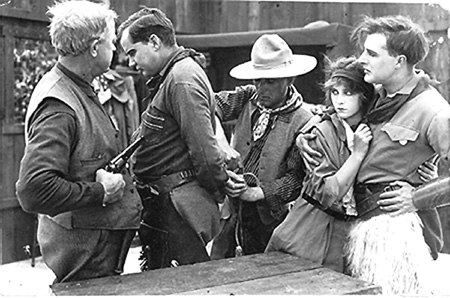 Volume II: Filmography
Volume II: Filmography Volume II: Filmography
Volume II: Filmography

Florence LaBadie and William Garwood, at right. Courtesy of Ralph Graham, M.D. (Q-20)
British release title: THE MAN SHE LOVED
July 8, 1913 (Tuesday)
Length: 1 reel (1,000 feet)
Character: Drama
Cast: Harry Benham (the preferred suitor), Ernest C. Joy (the rival)
Notes: 1. An expanded story, by O.M. Ware, based on the scenario of the film appeared in the August 1913 issue of The Photoplay Magazine. 2. The title of the film was given erroneously as For the Man She Saved in The Motion Picture Story Magazine, December 1913.
SYNOPSIS, The Moving Picture World, July 19, 1913:
"The ranchman's daughter had two suitors, both her father's employees. One was a clear-cut, intelligent young cowboy, energetic and ambitious; the other, capable in his way, but sullen and revengeful. The girl liked the first of the two, and as her father was quite content with her choice, the course of true love seemed to be running smoothly. On one occasion, while the girl and her father, escorted by the two cowboys, were off on a business trip, they camped on the summit of a mountain. The girl was standing at the edge of a cliff. Her bracelet fell off, and as all supposed, rolled thousands of feet into the chasm below. She agreed with her father, however, that search for the jewel would be useless.
"The favored cowboy planned a surprise, however, partway down the cliff a ledge of rock jutted out, and he figured that perhaps the bracelet was lodged there. One day when work permitted, he rode away from the ranch and halted at the cliff. He tied a rope to the tree, lowered himself down to the ledge, and there made a diligent search, being finally rewarded by finding the bracelet. Unfortunately for him, his rival had noticed his departure from the ranch, and followed him. In jealous rage the vengeful cowboy pulled up the rope, leaving his rival to die of exposure and starvation.
"When her sweetheart failed to return to the ranch that night, the girl was worried, and intuitively suspected that the rejected suitor was to blame for the strange disappearance. The next morning she saw him ride away and followed. He went to the edge of the cliff to hurl taunts at his helpless victim, and then rode away. The girl, who had been in concealment, emerged after he had departed, and single-handed rescued her sweetheart, who was unconscious and near death. When he had been revived he returned to the ranch, there to confront his enemy, who at first believed him a ghost, but realized, when the hand of the law fell upon him, that his plot had failed through the girl's devotion to the man she loved."
REVIEW, The Morning Telegraph, July 13, 1913:
"Not especially strong in plot, this picture is still able to hold a certain amount of interest. It is the story of rival cowboys and the losing of a bracelet over a cliff. The girl's favorite, recovering the bracelet, is treacherously cut off from a means of return by his rival, who pulls up the rope by which the young man has lowered himself to a ledge of the cliff. His sweetheart, suspecting foul play, later rescues him."
REVIEW, The New York Dramatic Mirror, July 9, 1913:
"A bracelet, given a girl by her choice of two men, falls down into a canyon. The favored man goes secretly to get it for her, lowering himself into the canyon by a rope. Just as he picks it up, his rival draws up to the line and leaves him to perish. Her lover not appearing, the girl suspects, and follows the rival as he goes to gloat over his enemy's misfortune. She goes down into the canyon, fastens the rope about the unfortunate man there, climbs up, and by tying the other end to her pony's saddle horn, drags him to the top. Aid comes. The guilty man is punished and the lovers united. A creditable production generally. The man drawn up over jagged rocks by the pony is an action having an air of improbability, but to object on this point would be hypercritical. The acting is animated and sincere."
REVIEW, The Moving Picture World, July 19, 1913: This review is reprinted in the narrative section of the present work.
# # #
Copyright © 1995 Q. David Bowers. All Rights Reserved.